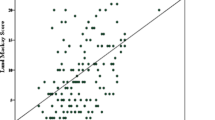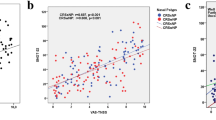Abstract
Objective of this study was to test whether there is a difference between chronic rhinosinusitis patients with (CRSwNP) and without (CRSsNP) nasal polyps in the association of extent of disease on CT scans with symptom severity and health-related quality-of-life (HRQL) impairment. Data sets from 271 chronic rhinosinusitis (CRS) patients who completed the Sino-Nasal Outcome Test 22 (SNOT-22) and visual analog scale (VAS) scores were subjected to principal component analysis (PCA) to identify a symptom components related to CRS. After controlling for demographics, medical therapy, and comorbidities, the association between symptom components/items excluded from PCA and Lund–Mackay score (LMS) was evaluated. No association was found between the total SNOT-22 score and LMS in CRS patients. There was an independent association between a higher “nasal” symptom component derived from SNOT-22 PCA and LMS in patients with CRSwNP (p < 0.001), but not in CRSsNP patients, with a statistically significant difference between two patient subsets (p = 0.003). In patients with CRSsNP, higher (worse) SNOT-22 “facial pain” was associated with lower LMS (p = 0.022), although the estimated change in LMS was modest. Considering VAS PCA components, higher “nasal” symptoms were associated with higher LMS in CRSwNP patients (p < 0.001) but not in CRSsNP, with a statistically significant difference between CRS groups (p = 0.024). A higher “pain” PCA component was associated with lower LMS in CRSsNP patients (p = 0.019). This study found significant differences in the relationship between symptom burden and CT scores between CRS phenotypes and no association between HRQL impairment and CT scores.
Similar content being viewed by others
References
Fokkens WJ, Lund V, Mullol J et al (2012) European position paper on rhinosinusitis and nasal Polyps 2012. A summary for otorhinolaryngologists. Rhinology 50:1–12
Lund VJ, Kennedy DW (1997) Staging for rhinosinusitis. Otolaryngol Head Neck Surg 117:S35–S40
Benninger MS, Ferguson BJ, Hadley JA et al (2003) Adult chronic rhinosinusitis: definitions, diagnosis, epidemiology, and pathophysiology. Otolaryngol Head Neck Surg 129:S1–S32
Bhattacharyya T, Piccirillo J, Wippold FJ 2nd (1997) Relationship between patient-based descriptions of sinusitis and paranasal sinus computed tomographic findings. Arch Otolaryngol Head Neck Surg 123:1189–1192
Stewart MG, Sicard MW, Piccirillo JF et al (1999) Severity staging in chronic sinusitis: are CT scan findings related to patient symptoms? Am J Rhinol 13:161–167
Basu S, Georgalas C, Kumar BN et al (2005) Correlation between symptoms and radiological findings in patients with chronic rhinosinusitis: an evaluation study using the Sinonasal Assessment Questionnaire and Lund-Mackay grading system. Eur Arch Otorhinolaryngol 262:751–754
Tan BK, Chandra RK, Pollak J et al (2013) Incidence and associated premorbid diagnoses of patients with chronic rhinosinusitis. J Allergy Clin Immunol 131:1350–1360
Chung SD, Chen PY, Lin HC et al (2014) Comorbidity profile of chronic rhinosinusitis: a population-based study. Laryngoscope 124:1536–1541
Lanza DC, Kennedy DW (1997) Adult rhinosinusitis defined. Otolaryngol Head Neck Surg 117:S1–S7
Hopkins C, Gillett S, Slack R et al (2009) Psychometric validity of the 22-item Sinonasal Outcome Test. Clin Otolaryngol 34:447–454
Morley AD, Sharp HR (2006) A review of sinonasal outcome scoring systems—which is best? Clin Otolaryngol 31:103–109
Bhattacharyya N (2008) Relationship between mucosal inflammation, computed tomography, and symptomatology in chronic rhinosinusitis without polyposis. Ann Otol Rhinol Laryngol 117:517–522
Wabnitz DA, Nair S, Wormald PJ (2005) Correlation between preoperative symptom scores, quality-of-life questionnaires, and staging with computed tomography in patients with chronic rhinosinusitis. Am J Rhinol 19:91–96
Ryan WR, Ramachandra T, Hwang PH (2011) Correlations between symptoms, nasal endoscopy, and in-office computed tomography in post-surgical chronic rhinosinusitis patients. Laryngoscope 121:674–678
Garetier M, Barberot C, Chinellato S et al (2013) Clinical-radiological correlation after functional endoscopic sinus surgery in patients with chronic rhinosinusitis: interest of a sinonasal aerial volumetry. Rhinology 51:162–170
Hopkins C, Browne JP, Slack R et al (2007) The Lund-Mackay staging system for chronic rhinosinusitis: how is it used and what does it predict? Otolaryngol Head Neck Surg 137:555–561
Kenny TJ, Duncavage J, Bracikowski J et al (2001) Prospective analysis of sinus symptoms and correlation with paranasal computed tomography scan. Otolaryngol Head Neck Surg 125:40–43
Toros SZ, Bölükbasi S, Naiboğlu B et al (2007) Comparative outcomes of endoscopic sinus surgery in patients with chronic sinusitis and nasal polyps. Eur Arch Otorhinolaryngol 264:1003–1008
Zheng Y, Zhao Y, Lv D et al (2010) Correlation between computed tomography staging and quality of life instruments in patients with chronic rhinosinusitis. Am J Rhinol Allergy 24:41–45
Browne JP, Hopkins C, Slack R et al (2007) The Sino-Nasal Outcome Test (SNOT): can we make it more clinically meaningful? Otolaryngol Head Neck Surg 136:736–741
DeConde AS, Bodner TE, Mace JC et al (2014) Response shift in quality of life after endoscopic sinus surgery for chronic rhinosinusitis. JAMA Otolaryngol Head Neck Surg 140:712–719
Sedaghat AR, Gray ST, Caradonna SD et al (2015) Clustering of chronic rhinosinusitis symptomatology reveals novel associations with objective clinical and demographic characteristics. Am J Rhinol Allergy 29:100–105
Deal RT, Kountakis SE (2004) Significance of nasal polyps in chronic rhinosinusitis: symptoms and surgical outcomes. Laryngoscope 114:1932–1935
Banerji A, Piccirillo JF, Thawley SE et al (2007) Chronic rhinosinusitis patients with polyps or polypoid mucosa have a greater burden of illness. Am J Rhinol 21:19–26
Eweiss AZ, Lund VJ, Barlow J et al (2013) Do patients with chronic rhinosinusitis with nasal polyps suffer with facial pain? Rhinology 51:231–235
Dietz de Loos DA, Hopkins C, Fokkens WJ (2013) Symptoms in chronic rhinosinusitis with and without nasal polyps. Laryngoscope 123:57–63
Tomassen P, Vandeplas G, Van Zele T et al (2016) Inflammatory endotypes of chronic rhinosinusitis based on cluster analysis of biomarkers. J Allergy Clin Immunol 137:1449–1456
Jones NS, Cooney TR (2003) Facial pain and sinonasal surgery. Rhinology 41(4):193–200
Hopkins C, Philpott C, Crowe S et al (2016) Identifying the most important outcomes for systematic reviews of interventions for rhinosinusitis in adults: working with Patients, Public and Practitioners. Rhinology 54:20–26
Pearlman AN, Chandra RK, Chang D et al (2009) Relationships between severity of chronic rhinosinusitis and nasal polyposis, asthma, and atopy. Am J Rhinol Allergy 23:145–148
Phillips CD, Platts-Mills TA (1995) Chronic sinusitis: relationship between CT findings and clinical history of asthma, allergy, eosinophilia, and infection. AJR Am J Roentgenol 164:185–187
Batra PS, Tong L, Citardi MJ (2013) Analysis of comorbidities and objective parameters in refractory chronic rhinosinusitis. Laryngoscope 123(Suppl 7):S1–S11
Contreras JI, Ferguson BJ, Wang EW et al (2013) The role of allergy therapy in chronic rhinosinusitis: a systematic review. Curr Otorhinolaryngol Rep 1:33–44
Abrass LJ, Chandra RK, Conley DB et al (2011) Factors associated with computed tomography status in patients presenting with a history of chronic rhinosinusitis. Int Forum Allergy Rhinol 1:178–182
Baumann I, Blumenstock G, Zalaman IM et al (2007) Impact of gender, age, and comorbidities on quality of life in patients with chronic rhinosinusitis. Rhinology 45:268–272
Katotomichelakis M, Simopoulos E, Tripsianis G et al (2014) The effects of smoking on quality of life recovery after surgery for chronic rhinosinusitis. Rhinology 52:341–347
Uhliarova B, Adamkov M, Svec M et al (2014) The effect of smoking on CT score, bacterial colonization and distribution of inflammatory cells in the upper airways of patients with chronic rhinosinusitis. Inhal Toxicol 26:419–425
Author information
Authors and Affiliations
Corresponding author
Ethics declarations
Conflict of interest
All authors declare that they have no conflict of interest.
Ethical approval
All procedures performed in studies involving human participants were in accordance with the ethical standards of the institutional and/or national research committee and with the 1964 Helsinki declaration and its later amendments or comparable ethical standards.
Informed consent
Informed consent was obtained from all individual participants included in the study.
Rights and permissions
About this article
Cite this article
Gregurić, T., Trkulja, V., Baudoin, T. et al. Association between computed tomography findings and clinical symptoms in chronic rhinosinusitis with and without nasal polyps. Eur Arch Otorhinolaryngol 274, 2165–2173 (2017). https://doi.org/10.1007/s00405-016-4446-y
Received:
Accepted:
Published:
Issue Date:
DOI: https://doi.org/10.1007/s00405-016-4446-y




